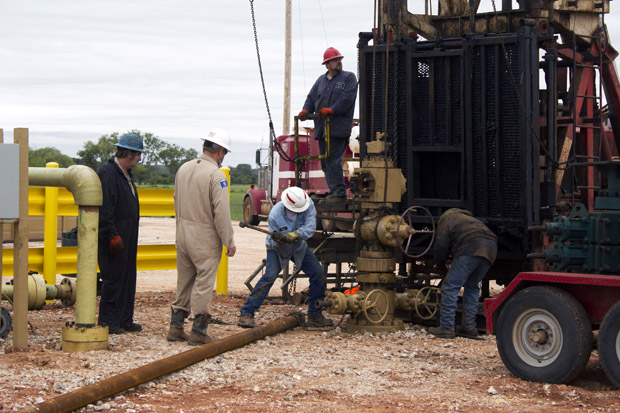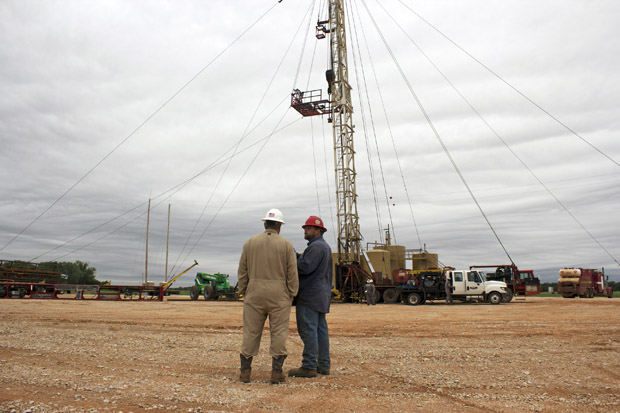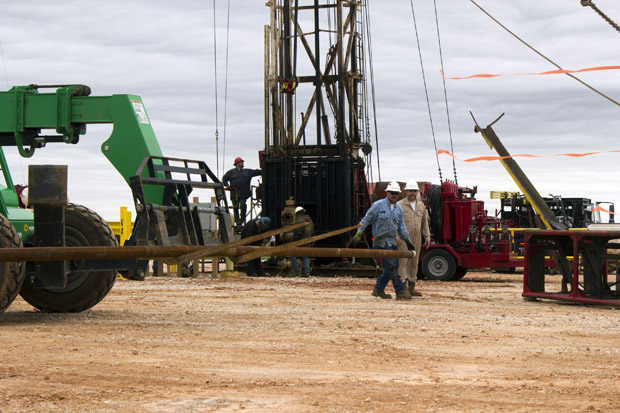
Oil-field workers use sledgehammers to unstick a pipe at the George saltwater disposal well near Wakita in northwestern Oklahoma.
Joe Wertz / StateImpact Oklahoma


Oil-field workers use sledgehammers to unstick a pipe at the George saltwater disposal well near Wakita in northwestern Oklahoma.
Joe Wertz / StateImpact Oklahoma

Joe Wertz / StateImpact Oklahoma
Oil-field workers use sledgehammers to unstick a pipe at the George saltwater disposal well near Wakita in northwestern Oklahoma.
Two burly men armed with sledgehammers take turns bashing a khaki-colored steel flange fastened to a pipe in the middle of a soggy, gravely lot near Wakita in northwestern Oklahoma.
The tangle of valves and fittings, called the Christmas tree, has to come off before Jay Storm’s crew can start their work in earnest.
“Everything is a little seized up this morning, so we’re having to manually try to get a couple different components separated by hand,” says Storm, completions supervisor for Tulsa-based Eagle Energy Exploration.
Storm and a half-dozen oilfield workers are opening up the George No. 1 saltwater disposal well, which is connected via pipeline to a pair of nearby production wells.
Those two wells produce oil and gas. And, like a lot of wells in Oklahoma, a lot of water comes to the surface with that oil and gas. The wastewater is salty and laced with petroleum products, chemicals and metals. That’s what George No. 1 is used for.
All the toxic wastewater from the two production wells is piped over and pumped nearly a mile and a half underground. Disposal wells are an economic and government-approved method of keeping toxic wastewater from contaminating public water sources, which are usually close to the surface.
But there’s a problem. George No. 1 is too deep.
“About two hundred feet,” Storm says. “Two hundred feet below the Arbuckle.”

Joe Wertz / StateImpact Oklahoma
Jay Storm, left, the completions superintendent for Eagle Energy Exploration, and a service company worker oversee the plug-back of the George No. 1 saltwater disposal well.
Scientists say disposal wells are likely behind the increased and atypical seismic activity recorded recently in Oklahoma and several other states.
For decades, the Arbuckle formation has been considered Oklahoma’s ideal place for disposal wells to pump full of drilling wastewater. The Arbuckle underlies most parts of the state, so it’s easy to find. Fluid goes in easy, and it’s nicely sealed off from aquifers and other sources of drinking water.
But the Arbuckle is situated above crystalline granite rock. Scientists say disposal wells that are too deep and allow fluid to contact the granite pose a risk for triggering earthquakes.
Fluid injection into granite rock is one of two well-known risk factors for manmade earthquakes. The second is fluid injection into faults — especially active faults known to produce earthquakes.
Researchers and regulators are focusing on disposal wells that might be too deep or too close to risky faults.

Joe Wertz / StateImpact Oklahoma
Oil-field workers lining up a section of pipe at the George No. 1 saltwater disposal well.
In March, Oklahoma’s oil and gas regulator ordered Eagle Energy Exploration and about 90 companies operating roughly 350 disposal wells in quake-prone parts of the state to provide measurements proving they aren’t injecting into granite basement rock.
If the wells are found to be injecting into the granite — through measurements called well logs or gamma ray tests — companies face three options: Shut down the well, cut disposal volumes by half, or “plug-back” — pump cement into the well so it’s shallower and away from the granite.
As of May 11, 2015, Eagle Energy and the owners of more than 50 other disposal wells opted to plug-back.
“To be in compliance with the Corporation Commission, we’re going to pull the casing out of it and the packer, and run in and cement the zone below the Arbuckle that we’re disposing in,” Storm says.
The Corporation Commission in 2014 enacted new rules requiring more detailed data and logs from disposal well operators. The agency has also been scrutinizing disposal well permits. But the disposal well orders — called “directives” — are its most aggressive to date. Officials at Eagle Energy Exploration estimate it will cost them $50,000 to $60,000 dollars to plug-back the George No. 1 saltwater disposal well.
StateImpact contacted scores of companies that received the disposal well directives, but Eagle Energy Exploration was the only operator who would speak on-record about its response or allow a reporter to observe the plug-back process firsthand.
“Once we get a good cement job on it, we’ll verify and double-check everything, and we’ll run the casing and packer back in and put it back to work,” Storm says.
Oklahoma had more earthquakes than California last year, but it’s too early to tell if the state’s regulatory actions will reduce the shaking. The rate of shaking doesn’t appear to be slowing. More than 5,400 earthquakes were recorded in Oklahoma last year; as of May 2015, more than 2,400 quakes have been recorded, data from the Oklahoma Geological Survey show.
Storm says he hasn’t really noticed all the earthquakes.
“To be honest, I’ve never felt one up here,” he says, and the quakes aren’t a big topic of conversation on the rig sites he’s been on. “There’s really no chatter about it whatsoever.”